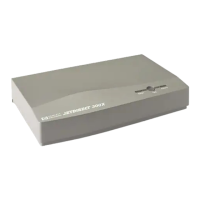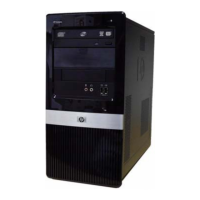For
HP
Internal Use Only
Solving High Humidity Problems
If
a sensor
in
the
DDS drive detects
that
the
humidity has risen above a safe
operating
level,
the
drive stops whatever
it
is doing,
unthreads
the
tape,
and
waits for
the
humidity
to
drop.
The
DDS drive will
not
respond
to
any commands until
the
sensor detects
an
acceptable level
of humidity. This
protects
the
drive
and
the
tape
media from damage.
Once
the
humidity has dropped
to
an
acceptable level,
the
DDS drive
must
be power cycled
before
it
can
be
used again.
Note
A high
humidity
fault indicates
that
the
customer needs
to
exercise
tighter
control on
the
operating
environment. Subjecting
the
DDS drive
(and
the
other
computer
equipment as well)
to
environmental extremes
may
shorten
the
life
of
the
drive.
The
operating
environment should
be
maintained
within
the
range recommended
in
the
system specifications.
Removing a Jammed Cassette From a DDS-Format Drive
If
a DDS cassette becomes
jammed
in
the
DDS drive,
try
either power-cycling
the
drive
or
a
hard
reset.
If
this fails
to
release
the
cassette,
the
cassette can
be
manually
extracted
from
the
drive as follows (see Figure 5-4):
1. Rewind
the
tape
to
the
Beginning
of
Media (BOM).
2. Switch off power
to
the
DDS drive
and
remove
the
DDS drive from
the
cabinet.
3. Remove
the
cabinet
mounting
bracket from
the
drive.
4. Remove
the
two
adapter
brackets from
the
drive.
5.
Insert a flat-blade screwdriver between
the
drive chassis
and
the
side
of
the
top
cover.
Pry
up
the
top
cover
at
two points
on
each side
of
the
top
cover
and
remove
the
top
cover.
6. Insert a size
00
flat-blade screwdriver
through
the
emergency eject access hole (1).
7.
View
the
tip
of
the
screwdriver from
the
left-hand side of
the
drive,
and
angle
the
screwdriver down
into
the
slotted head
of
the
worm gear (2).
8.
Rotate
the
screwdriver counter-clockwise
and
watch
the
worm gear
to
make sure
it
is
rotating.
You
must
rotate
the
worm gear several
hundred
times because
of
its
small
diameter.
Caution
'
•
When
the
tape
is
unthreaded,
a loop of
tape
will be hanging
out
of
the
cassette. Be careful
not
to
let any grease
in
the
threading
slots
contaminate
the
tape.
• As
the
cassette is ejected,
the
cassette door will close on
the
loop
of
tape
and
may
crease
the
tape.
If
the
tape
was
at
BOM
before
starting
this
procedure,
the
crease will occur where no
data
is
written.
However,
if
the
tape
was
not
at
BOM, damage
to
the
tape
may
occur
and
data
may
be
lost.
Troubleshooting 5-63
